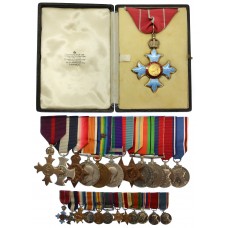An Excellent WW2 C.B.E. (Military) and WW1 Distinguished Service Cross (Immediate) Medal Group of 13 - Air Vice-Marshal C.W. Nutting, Royal Air Force (Late R.N.V.R. and R.N.A.S.)
- Product Code: MM-5536
- Era: WW1 and WW2 Availability: Out of Stock
-
Price: £5,495.00
An excellent Second World War C.B.E., First World War D.S.C. medal group of thirteen awarded to Air Vice-Marshal Charles William Nutting, Royal Air Force, (late Royal Naval Volunteer Reserve and Royal Naval Air Service), who having been decorated for his gallantry as an Observer in the No. 1 Wing at Dunkirk and gained acclaim as an innovator in wireless telegraphy for aircraft, rose to senior rank in the R.A.F. and was awarded the C.B.E. for his services as Assistant Chief of Air Staff in the Directorate of Signals.
Commander of the Most Excellent Order of the British Empire, C.B.E. (Military) unnamed as issued, in Garrard & Co. case of issue
Officer of the Most Excellent Order of the British Empire, O.B.E. (Military) unnamed as issued (hallmarks for London 1919
Distinguished Service Cross privately engraved to Lieut.C. W. Nutting, Flanders, 1916 (hallmarks for London 1915)
1914-15 Star named to Lieut. C. W. Nutting, R.N.V.R.
British War Medal named to Lt. Commr. C. W. Nutting, R.N.V.R.
WW1 Victory Medal (with MID oak leaf emblem) named to Lt. Commr. C. W. Nutting, R.N.V.R.
General Service Medal (Clasp - Iraq) named to S./L. C. W. Nutting, R.A.F.
1939-45 Star unnamed as issued
Africa Star unnamed as issued
WW2 Defence Medal unnamed as issued
War Medal 1939-45 unnamed as issued
1935 George V Silver Jubilee Medal unnamed as issued
1937 George VI Coronation Medal unnamed as issued
Together with accompanying set of miniature medals and original identity cards for travel in the Middle East in 1944.
D.S.C. London Gazette - 22nd June 1916.
The original recommendation states:
‘Lieutenant Nutting joined No. 1 Wing at Dunkirk in April 1915. During the past year he has been continually employed in coastal reconnaissances and as an aerial Observer for gun fire.
Owing to his technical knowledge of wireless telegraphy, he has largely developed this branch of aerial science. He successfully installed the first receiving W./T. apparatus in aeroplanes with rotary engines, and with Flight Lieutenant G. H. Beard, successfully carried out night spotting by moonlight with General Wolfe on Westende.
He has been continually employed in aerial spotting for Monitors’ gun fire and has been largely responsible for the successful results obtained.’
M.I.D. London Gazette - 28th October 1921
C.B.E. London Gazette - 11th July 1940
Charles William Nutting, who was born in April 1889, was appointed a Lieutenant in the Royal Naval Volunteer Reserve in March 1915.
Shortly afterwards he joined No. 1 Wing at Dunkirk as an Observer and W./T. Officer, in which capacity he flew many missions by day and night, and was responsible for greatly improving wireless telegraphy. Indeed Nutting’s expertise was later employed aboard the seaplane carrier H.M.S. Riviera, important work that prompted Admiral Sir Reginald Bacon to give him due credit in his definitive history of the Dover Patrol:
‘Exceptionally good progress was made in wireless telegraphy under the guidance of Lieutenant Nutting. A new type of sending and receiving set was supplied, and this was successfully fitted to various types of machines and thoroughly tested’ (Dover Patrol, refers).
As noted by his service record, he also distinguished himself for gallant spotting work, when he was ‘deserving of much credit for flying on 26 January 1916, and other dates, almost continuously under A.A. fire and successfully spotting the fire of the monitors.’
Transferring to the newly established Royal Air Force in April 1918, Nutting quickly gained advancement to Squadron Leader and was awarded the O.B.E. for his work as a Communications Officer on the Technical Staff during the Iraq operations of December 1919 to November 1920 (London Gazette 28 October 1921 refers).
Advanced to Wing Commander in January 1926, while serving on the Staff of the Signals Branch, and to Group Captain in January 1933, he became Director of Signals at the Air Ministry in April 1937, in which capacity he was serving on the renewal of hostilities in September 1939 - he was a member of the committee that met delegates to discuss supplying British fighters in defence of Poland (C.B.E.).
In April 1940, Nutting transferred to the Technical Branch, and in January 1941, on being advanced to Air-Vice Marshal, he reached the pinnacle of his chosen profession - namely as Director-General of Signals. But he was placed on the Retired List in the following year, when he took up appointment as Telecommunications Adviser to the Minister Resident in the Middle East. He retired to Galmpton, near Kingsbridge, Devon, after the War and died in February 1964
We take great pride in our stock and will always strive to bring you genuine items. All our items are carefully checked to make sure they are authentic original pieces.
Having worked in the field for many years we appreciate that there can occasionally be differences of opinion. This is why we have a no quibble returns policy on ALL items. If you want to return any purchase, for whatever reason, we will issue a full refund including your postage costs.
PAYMENT:
We accept payment by:
Credit and debit cards
Cash (any currency)
U.K. postal orders
Sterling cheques
PayPal
Exchange of goods
SHIPPING:
Our standard shipping costs apply on almost all of our items. The prices are as follows:
UK Standard Delivery - £3.45
UK Special Delivery - £9.95
Europe Priority Airmail - £10.95
Rest of World Priority Airmail - £11.95
Some large/heavy items may incur extra shipping costs. This will be clearly marked in the description and all prices will be shown before any payment is taken.
For more information on payment and shipping please click here
Tags: Gallantry, Military Medals, Campaign Medals, Gallantry Medals, British Medals, WW1 Medals, WWI, World War One, First World War, World War Two, WW2, RAF, RNAS, RNVR






















